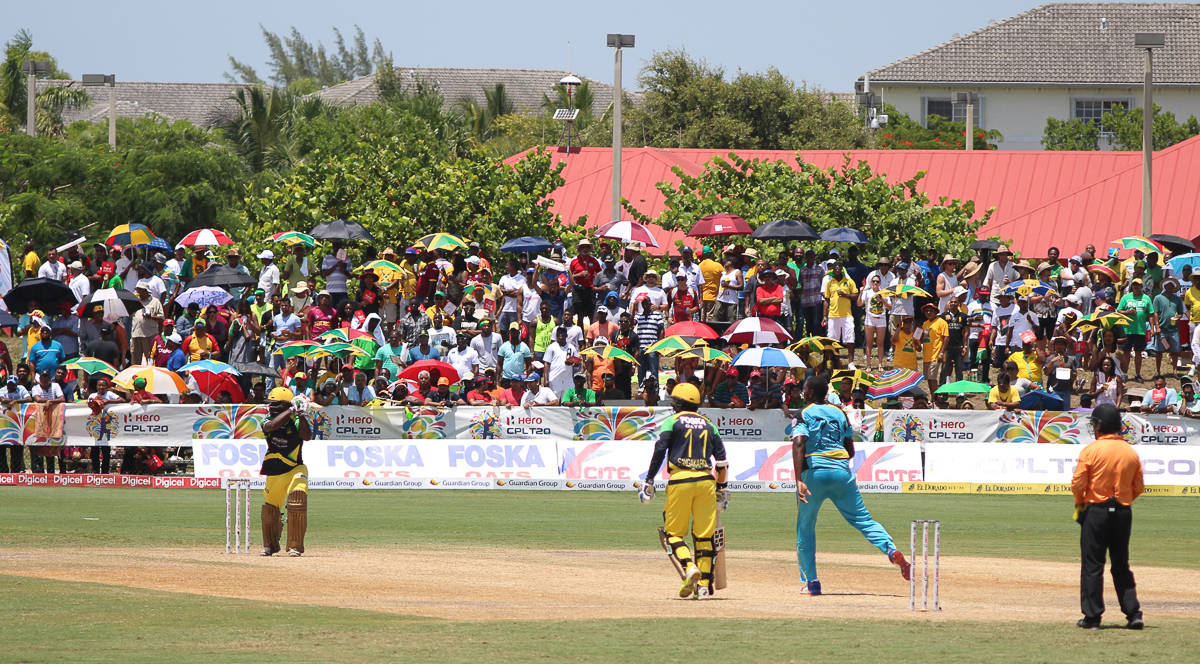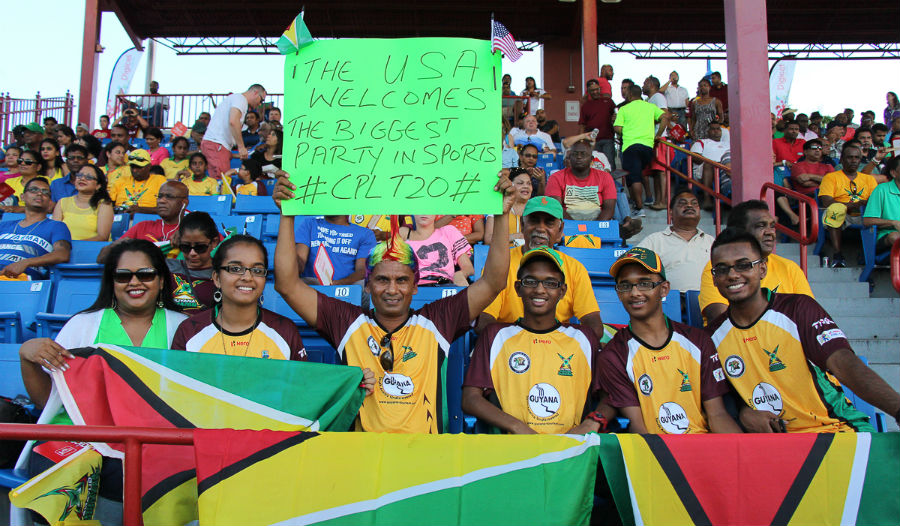 This year for the CPL matches in Lauderhill, temporary canopy or shaded overhang will be provided for fans on the grass embankment on the north side of the ground © Peter Della Penna
This year for the CPL matches in Lauderhill, temporary canopy or shaded overhang will be provided for fans on the grass embankment on the north side of the ground © Peter Della Penna
Caribbean Premier League organisers have reaffirmed their faith in making annual visits to the USA as the 2017 edition approaches, with the opening weekend taking place in Lauderhill on August 5 and 6. CPL chief executive Damien O’Donohoe and chief operating officer Pete Russell have told ESPNcricinfo they plan to stay the course in Florida despite a “considerable” financial loss made in the first visit last year.
“A lot of people in the Caribbean would say, ‘What’s the relevance to continually taking games back to the USA?'”, Russell said in an interview ahead of the upcoming season. “For us it is very much that we want a long-term partnership with US cricket or Canadian cricket.
“The long-term play is to make sure that we get teams represented in USA or Canada. That would be ideal for everyone, I think, to obviously take part in the CPL because then you have some residents locally and I think for cricket in America it would make a big difference because they would have a team to support. We’re happy to go back every year if need be. I think the challenge for us is that last year, we lost a reasonably large sum of money. We don’t look at it like that. We look at it as more of an investment.”
The CPL was the first overseas Twenty20 franchise league to stage games in the USA, with six games played from July 28 to 31 in Lauderhill. However, this year’s slate was trimmed from six to four matches, with a pair of weeknight matches axed compared to last year.
The two opening games in Lauderhill in 2016 were the least attended – the stadium’s flexible capacity was capped at 10,000 but attendance was approximately 50% for the two weeknight games – and the majority of fans in Florida were not locals. Touring fans helped make for sellout crowds on Saturday and Sunday, a major factor in the decision to only schedule weekend games this season.
“70% of the audience were flying in for these games so it made sense that we base that around the weekend and do one big weekend of cricket as opposed to playing games during the week where there isn’t a huge audience in south Florida,” O’Donohoe said. “Obviously the cost of putting on these games are expensive so we felt the weekend is the best option for 2017.”
Another reason to cut the weeknight games was the exorbitant costs of temporary support infrastructure. The floodlights at the Central Broward Regional Park are not approved to international standard and organisers had to pay for extra temporary floodlight fixtures to be brought in solely for the first two matches. Last year’s twin weekend double-headers also ended after sunset, with the first game starting at noon and the second at 4pm.
This year, the weekend double-headers have been pushed back an hour to take advantage of more daylight and to cash in on the Indian market with the first match starting at 8.30pm IST.
“It’s always a balancing act,” Russell said. “That’s a job for our operations team this year to make sure that the experience is a lot cooler, not that we can affect the weather but what we do at the stadium. The challenge that we had from an operations perspective last year was certainly in terms of lighting the stadium. That was a big challenge.
“We’re hoping fans come out because there’s nothing like watching the event live and all we can do is try to make it as comfortable as possible for the fans.”
The number one complaint from fans in 2016 was the lack of amenities to deal with the sweltering humidity at the stadium. As part of that commitment to improve, O’Donohoe and Russell said that there will be a temporary canopy or shaded overhang provided for fans on the grass embankment on the north side of the ground.
 The number one complaint from fans in 2016 was the lack of amenities to deal with the sweltering humidity at the stadium © Peter Della Penna
The number one complaint from fans in 2016 was the lack of amenities to deal with the sweltering humidity at the stadium © Peter Della Penna
Enhancements like that help justify the increased prices for this year – an over 50% hike on grandstand seats from $42 to $65 as well as a $5 increase on general admission tickets to $35. With the majority of gate revenue provided by out-of-towners who are already digging deep on flights and hotels to get to south Florida, organisers could easily have hiked prices even more – as was done by the BCCI when the cheapest seat for last year’s T20Is against West Indies was $100 and a grandstand seat $150.
However, O’Donohoe said he felt that such a strategy was not in line with their mission to make the CPL a family entertainment experience. Compared to other pro-sports teams in south Florida, the CPL tickets are more expensive than a Miami Marlins baseball game – bleacher seats are $12 for some games and a seat behind home plate as little as $20 for weeknights and $45 on weekends – but less than most tickets to watch the NFL’s Miami Dolphins. For the Dolphins, the cheapest field-level seat for most games in 2016 was $102 though an upper deck seat could be bought for $38 at some games and $72 for others.
“From day one, we’ve always tried to make our tickets as reasonable as possible so that they were available to the ordinary man on the street,” O’Donohoe said. “I think that’s something that we’ve done very successfully, especially in the Caribbean. We went into America for the first time last year and we deemed the games a success but when we looked at the books and saw that we lost a considerable amount of money, the one area where we felt we could charge more was in relation to the ticket price because we thought it was very low.
“What we wanted to do was still keep it reasonable and we don’t think reasonable is the price that the BCCI was charging and it’s not something we want to get to.”
O’Donohoe had said before last year’s games that his number one goal was to sellout the event. That goal has not changed and he says even with the price increases for certain sections, the goal is still achievable.
“When you’re going into a new market, filling stadiums is your number one priority. We’ve spoken to the NFL and NBA in terms of what they’re doing in the UK and for them, filling stadiums is their number one priority still. So I think that’s really important for us. There’s a slight ticket increase. We’re still very hopeful that the two days of cricket will sell out.”
Organising events away from the games is also part of the CPL’s foray into Florida. For 2016, these included a series of youth clinics by Jamaica Tallawahs headlined by coach Paul Nixon and Kumar Sangakkara, a joint CPL-ICC coaching seminar run by Tom Moody and an ICC umpiring seminar. There was also an exhibition match between CPL Developmental XI and a USA XI while the USA players were invited to train daily with the CPL squads. Many of these activities are expected to be repeated and Russell hopes scheduling the USA slate at the start of the season will lead to more engagement from teams whose end-of-season itineraries last year were crammed.
“We have a joint partnership with the ICC in terms of their development program so it made sense to have all the players from the four teams fly in so we get a good run-up with five days before the first game so we can do a lot of that work,” Russell said. “If we did it towards the middle or end of the tournament, we just wouldn’t have the time to do that so it just sort of works for everyone.”
Peter Della Penna is ESPNcricinfo’s USA correspondent. @PeterDellaPenna
© ESPN Sports Media Ltd.
Source: ESPN Crickinfo
